by W. Cranshaw* (1/20)
Quick Facts…
- Douglas-fir tussock moth caterpillars feed on needles of spruces, Douglas-fir and true firs.
- Numerous natural enemies attack Douglas-fir tussock moth and these will often control outbreaks after a season or two. A virus that produces “wilt disease” is a particularly important natural control.
- The potential for problems can be predicted by surveying for egg masses before eggs hatch in late spring.
- Several insecticides can be used to control Douglas-fir tussock moth during outbreaks.
 Figure 1: Adult males of the Douglas-fir tussock moth. |
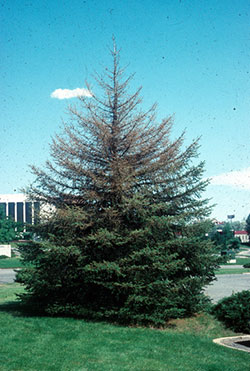 Figure 2: Blue spruce that has been partially defoliated by Douglas-fir tussock moth. |
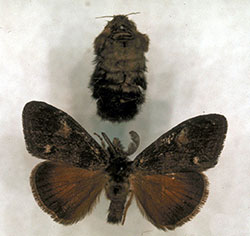 Figure 3: Females of the Douglas-fir tussock moth (top) are wingless. Males (bottom) are winged and fly well. Photograph by Jerald E. Dewey, USDA Forest Service/Bugwood.org |
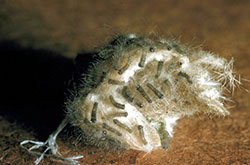 Figure 4: Douglas-fir tussock moth caterpillars at egg hatch. These very small, hairy caterpillars can be wind-blown, which is the primary way this insect disperses. Photograph by Jerald E. Dewey, USDA Forest Service/Bugwood.org |
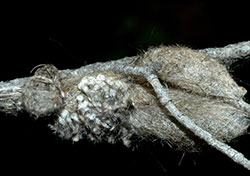 Figure 5: An adult female Douglas-fir tussock moth (left) laying a mass of eggs alongside the cocoon from which she recently emerged. Photograph by William M. Ciesla/Bugwood.org |
 Figure 6: Cocoons of the Douglas-fir tussock moth. Photograph by William M. Ciesla/Bugwood.org |
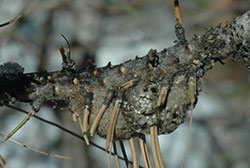 Figure 7: Egg mass of Douglas-fir tussock moth. Photograph by William M. Ciesla/Bugwood.org |
 Figure 8: Cocoons of Douglas-fir tussock moth attached to a wall adjacent to a spruce tree. Full-grown caterpillars often will leave the host plant and pupate in the near vicinity, attaching cocoons and, later, laying eggs on these other surfaces. Photograph by David Leatherman. |
Caterpillars of the Douglas-fir tussock moth (DFTM), Orgyia pseudotsugata, chew the needles of spruces, Douglas fir and true firs. Most problems in urban forests along the Colorado Front Range have involved blue spruce.
During outbreaks the caterpillars can extensively defoliate plants, feeding first on the new growth then later moving to older needles. Injury typically is first concentrated at the top of the tree but can involve the whole during severe outbreaks. Tops of heavily damaged trees may be killed, sometimes after only a single season of severe injury. Stresses from needle loss can also weaken plants so that they become more susceptible to effects of bark beetles, such as spruce ips, or fungi that produce cankers on branches.
Douglas-fir tussock moth caterpillars also can cause problems because the larval hairs can be irritating and are capable of producing a painful rash. Individual reactions to the hairs are highly variable with some people reacting strongly following exposure while others have little reaction.
Description
Young tussock moth caterpillars are blackish with long body hairs, producing brightly colored tufts of hair as they grow larger. A mature larva is 1.2-1.4 inches long, with a gray to brown body and shiny black head. Two long tufts of black hairs project forward from the head, and a similar tuft projects backward from the rear of the body. Dense, light brown patches of hairs and red spots occur on the first four and the last abdominal segment and there is an orange stripe on each side.
The cocoon surrounding the pupal stage is brownish gray and covered with hairs from the body of the larva. Cocoons usually are attached to foliage but may be found on tree trunks, rock, or other objects in the vicinity of a previously infested tree.
The adult males are moths with rusty-colored forewings and gray-brown hind wings, with a wing-span of about one inch. Females are thick-bodied and wingless, found in close association with the spot where they earlier pupated.
The egg mass, laid on the pupal cocoon of the female, contains about 300 white spherical eggs laid in several layers. The entire mass is covered with a frothy substance that is intermixed with grayish body hairs of the mother. Movement of Douglas-fir tussock moth into new locations around the state sometimes result from humans incidentally moving construction materials or other items that have attached egg masses. Where urban landscape plantings are located near forested areas where DFTM outbreaks occur, some colonization may occur from windblown larvae.
Life History and Habits
Douglas-fir tussock moth spends the winter as an egg within the egg mass. Eggs hatch in the spring, often in late May, typically following bud break. The small, hairy caterpillars migrate, moving to the new growth but also often dispersing upwards in the trees. This latter habit allows some of the caterpillars to be blown on wind current, which can carry the small, early stage caterpillars that designed for such wind dispersal. Since the adult female moths do not fly, wind-blown movement of young larvae is the most important means of initiating new infestations.
The caterpillars first feed solely on the newer foliage, and partially eaten needles may wilt and turn brown. Later, the older caterpillars will move to older needles as the more tender needles are eaten. During feeding, particularly when disturbed, larvae may drop from branch to branch on long silken strands. By mid-July or August, the larvae become full grown and many may migrate away from the infested tree. They pupate in brownish spindle-shaped cocoons in the vicinity of the infested trees.
The adults emerge from late July through mid-August. The males are winged and are strong fliers, but the females have only minute, non-functional wings. Mating occurs in the immediate vicinity of the female pupal case and they then lay their characteristic mass of eggs covered with grayish hairs. There is one generation produced per year.
Management in Landscape Plantings
Outbreaks of Douglas-fir tussock moth are cyclical due to effects of several important natural controls. At least seven species of parasitoid wasps and a tachinid fly attack and develop within developing larvae and pupae. Caterpillars may be killed by general predators, notably spiders. Bird predation on tussock moth caterpillars is considerable during the early larval stages but the longer, dense hairs on larger caterpillars makes predation by most bird species difficult.
During a Douglas-fir tussock moth outbreak often the most important biological control is a virus (Douglas-fir tussock moth nuclear polyhedrosis virus/NPV) that produces a lethal “wilt disease” in caterpillars. Infected caterpillars (“hangers”) droop from stems and needles, often hanging by a proleg. When their body ruptures millions of virus particles are released which can persist for years, later producing new infections, which often will greatly suppress Douglas-fir tussock moth populations for years after the wilt disease outbreak.
If there has been an outbreak of wilt disease in the previous year there is very high likelihood that the Douglas-fir tussock moth outbreak has ended. To confirm this, the site can be surveyed for the presence of new egg masses in winter and early spring. If surveys are conducted after fresh egg masses are laid (usually by August) and egg masses are present in low numbers, then there is high probability that there is very little risk of an outbreak the following spring. When unhatched egg masses are easily found on or in the near vicinity of known host trees, a higher potential risk exists for injury. However, even under these conditions trees should be monitored shortly after bud break to confirm the presence of feeding larvae before treatments are considered.
Several effective chemical controls are available to control Douglas-fir tussock moth in landscape settings (Table 1). Sprays should target the new growth and must be applied to thoroughly cover the top of the tree, where damage is concentrated. As younger larvae are much more effectively controlled than older larvae, treatment timing is best shortly after eggs have hatched. Egg hatch can be monitored by periodically checking egg masses on the tree, looking for evidence that the eggs have hatched. Empty eggs and small holes in the egg mass made by the exiting caterpillars are signs present following egg hatch. Depending on location and weather conditions egg hatch should occur sometime between midMay and midJune, around the time of bud break.
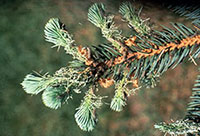 Figure 9: New growth of blue spruce being damaged by recently hatched caterpillars of Douglas-fir tussock moth. Photograph by David Leatherman. |
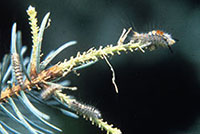 Figure 10: Caterpillars of the Douglas-fir tussock moth first feed on the tender needles of the new growth, then move to older needles. Photograph by David Leatherman. |
 Figure 11: A Douglas-fir tussock moth killed by a virus disease. The dead larvae, known as “hangers”, typically remain attached to the plant by only one or two prolegs. The body of the infested caterpillar ultimately will rupture and release virus particles that will cause new infections. Photograph by Tom Eckberg, Idaho Department of Lands. |
Table 1. Insecticides useful for control of Douglas-fir tussock moth on trees in residential sites and municipal sites. Examples of trade names of products are in parentheses.
spinosad (Conserve, ferti-lome Borer, Bagworm, Leafminer & Tent Caterpillar Spray)
chlorantraniliprole (Acelepryn)
permethrin (Astro, Tengard, Permethrin, various retail formulations)
bifenthrin (Onyx, Bifen)
cyfluthrin (Tempo)
lambda-cyhalothrin (Demand, Scimitar, Cyonara, Spectracide Insect Killer for Lawns and Landscapes)
The original version of this publication was produced by R.E. Stevens of the Rocky Mountain Forest and Range Experiment Station, D.A. Leatherman, entomologist with Colorado State Forest Service and J.W. Brewer with the former Department of Zoology and Entomology of Colorado State University. Revised by W. Cranshaw, entomologist, Extension, Colorado State University. 3/95. 1/20.
Go to top of this page.





